Test drive Audi e-tron

In 2009, Audi introduced the concept of the e-tron family of electric vehicles (and hybrids). Concepts were shown at exhibitions, made promises, predicted, designed, surprised, made promises again, prepared the platform, and after some 10 years, the e-tron went on sale. The resulting car looked like the original concepts in the same way as 2019 is like 2009 - the numbers are almost the same, and the times are completely different.
2019 year. The market leader in electric vehicles is well known to everyone. Other manufacturers are threatening to bring to light the next "killer"
The first Audi e-tron was brought to my city (Victoria, BC, CA) back in the winter. They brought, showed at a magnificent presentation to good music, wines and snacks to specially invited guests (owners of the premium segment from VW) and were immediately taken away. He was taken across the country from province to province without the possibility of a test drive, but with the possibility of pre-order. A few months of very sluggish sales in Canada led to the fact that in the summer in my city there were already 2 of them waiting for the buyer and one for the "ride", which I did not slow to use.
Main characteristics:
Mileage between exercises - 329 km .
Acceleration 0-100 km / h - 5.7 seconds .
Battery - 95 kWh
The maximum charging speed is 150 kV t.
Four-wheel drive.
The drag coefficient is 0.28
Price in the USA - from $ 74,800 USD
You have to pay tribute to Audi. Unlike all other major manufacturers, she was not

At 11 a.m. I wrote a letter to Audi Victoria, and at 11:45 they already called me back and informed me that I could do a test drive at any time convenient for me. At 12:15 I was already in the store:

Why am I focusing on this? Because this is a new and very rare car, a ride on which there should be many who want, and therefore there should be a queue that did not turn out to be. For comparison, the queue for test drive of any Tesla model in Vancouver, BC, CA, even a few months after the start of sales, was still several days (despite the fact that Vancouver has as many as three Tesla Show Rooms). At the same time, Tesla does not have an advertising company, but they tell about e-tron from every “iron” - in TV ads, in cinemas, magazines, reviews, and even the World Ski Cup 2018-2019 was “from start to finish” hung with posters of the official sponsored by Audi e-tron.
One way or another, it was to my advantage and here I am in the store - the e-tron is the only one who was put out to attract customers:

I asked to put my car on charge (Audi Victoria has both a level 2 charge and a fast 150 kW), showed Driver's License, I was very briefly asked which car I was looking for, the proposed use case, which for me could be the most important in a car, treated to good coffee and, finally, led to an electric car from Audi:
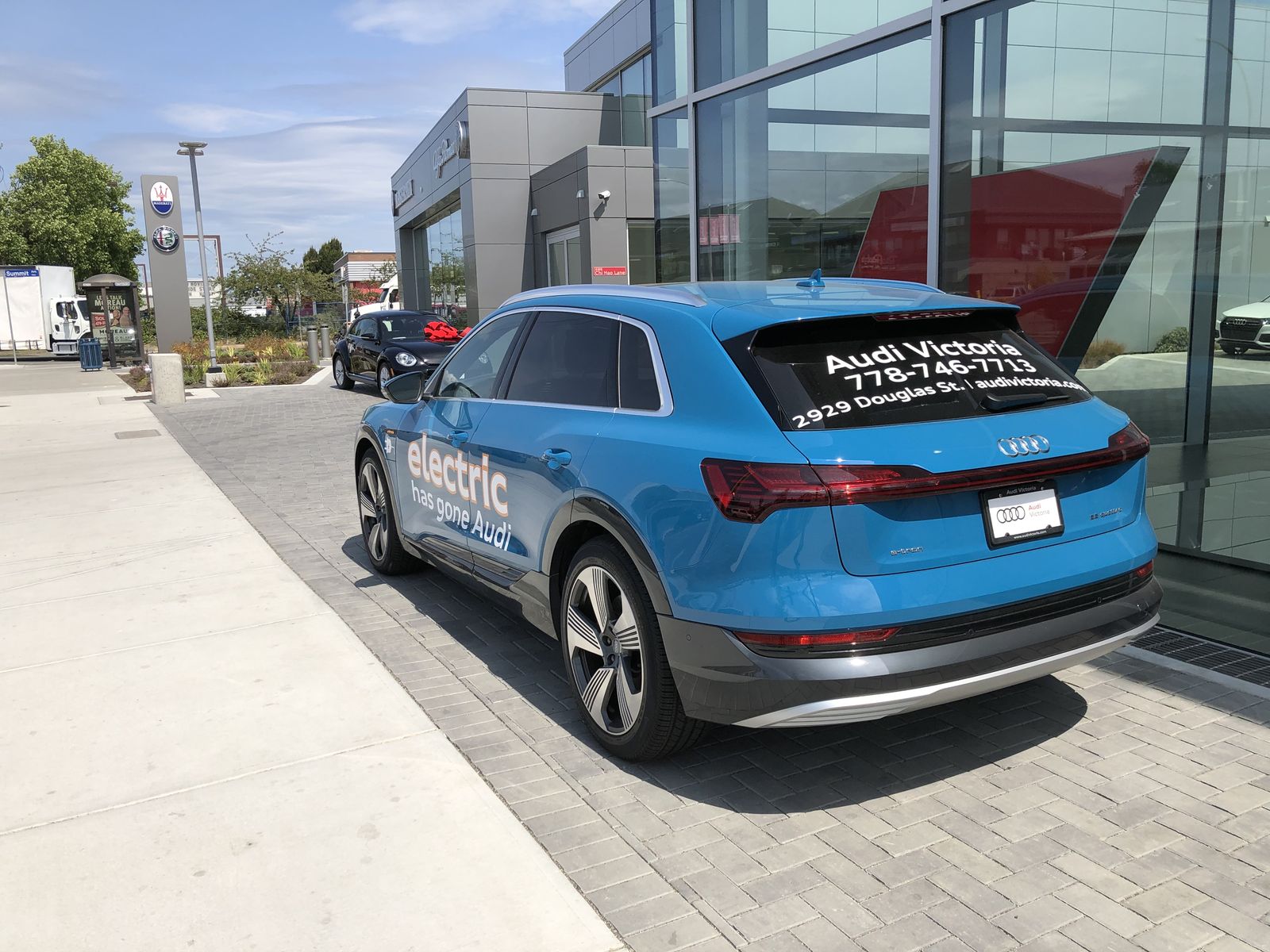
According to the manager. Yes, by the way, almost everything that I already wrote about and will continue to talk about is either information from the manager, or my personal subjective, which means that they are not accurate and do not pretend to be true . So here. According to the manager, the car has a unique color, in addition to this, the highest quality workmanship - for example, body panels are connected by laser welding. The car looks relatively small - something in size between the Audi Q5 and Audi Q7. I would say that outwardly it is "nondescript", especially against the background of other 2019 Audi.
The blame for the smooth radiator lining, now fashionable but still unsuccessful “aerodynamic” wheels and some completely modest, simple and somewhat smooth forms:

It’s possible to guess that this is an electric car from afar, for example, from disks:

e-tron next to other Audi:
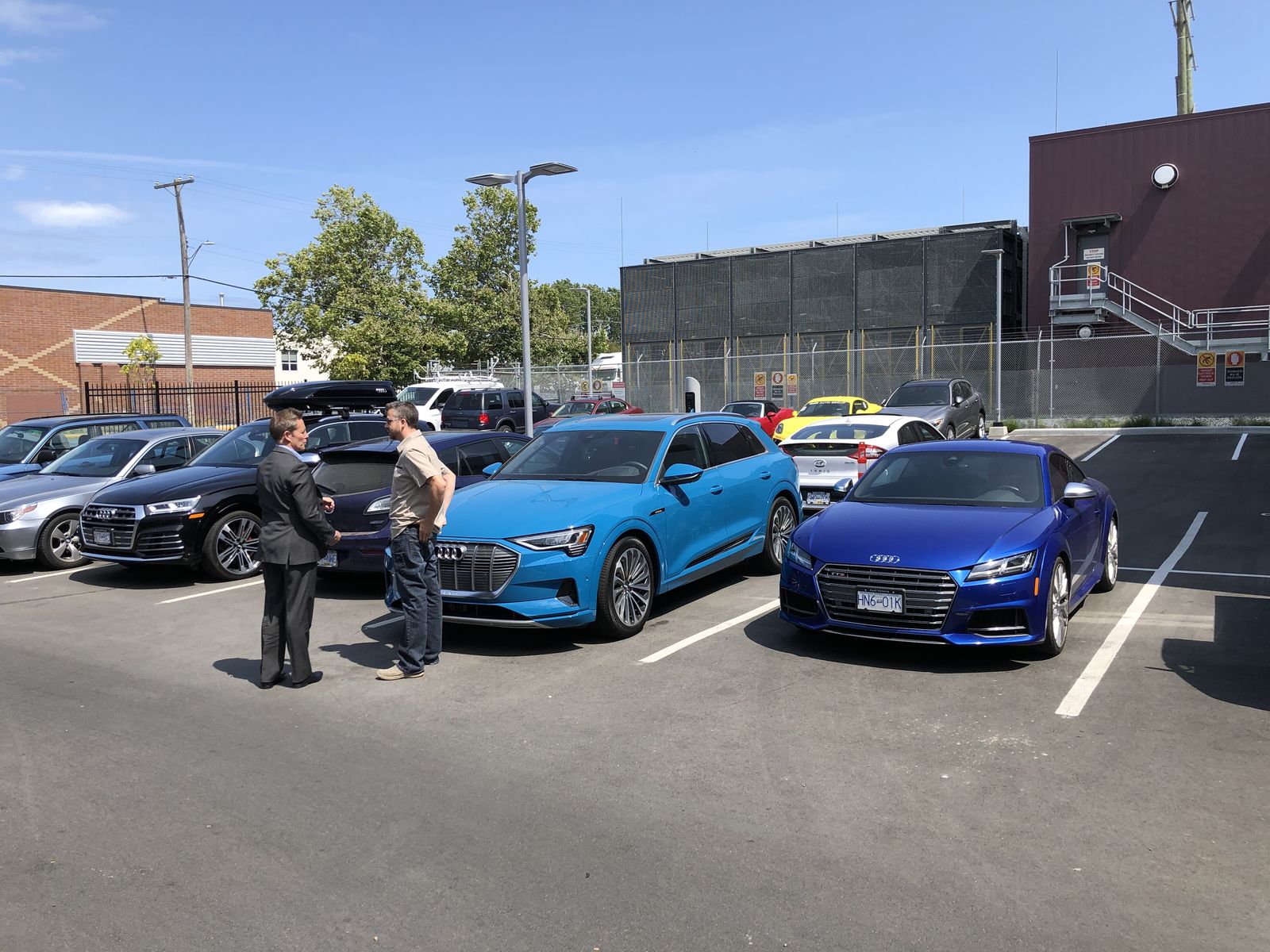
The doors are unlocked using a conventional key fob - the same as the rest of Audi. At the same time, it’s convenient that you don’t need to press the button on the key fob or the door itself - it unlocks itself when the owner with the key fob in his pocket pulls the door handle towards himself, and in order to lock it, you just need to run your hand from the outside of the handle. What could be more convenient? What Tesla did in Model 3 - the car opens and closes automatically when the owner approaches or leaves with the phone with bluetooth turned on - no extra trinkets or movements at all. You come to an always open car and you never need to think about whether it closed or not when you left. But here, again, there is a small but. For example, my good friend. He has an Android phone (some kind of Samsung from the latter) and occasionally Model 3 does not open when he approaches it - you have to restart bluetooth. His wife has an iPhone X and has no problems with it.
The trunk is very roomy:

At the same time, it is so deep that there was enough space for an almost full-fledged spare tire:

There is an opening and closing of the tailgate with your foot - it is very convenient if you transfer a box of food from the Costco basket to it and then take it out to bring it home. Another convenient thing is that there is a button on the trunk door to lock all the doors. It’s convenient, but not for Model 3 owners - they don’t need such a button, since the machine will close itself when the owner leaves it.
The rear row of seats is roomy with a "theatrical fit" - i.e. the seats are located high, which, according to the manager of Audi improves the visibility of the rear passengers and increases safety in side impact. Sitting comfortably is a very large space between the knees and the front seat, but when I was not very tall (182 cm) I was close to hitting the ceiling with my head. There is its own climate control zone, a couple of USB ports:
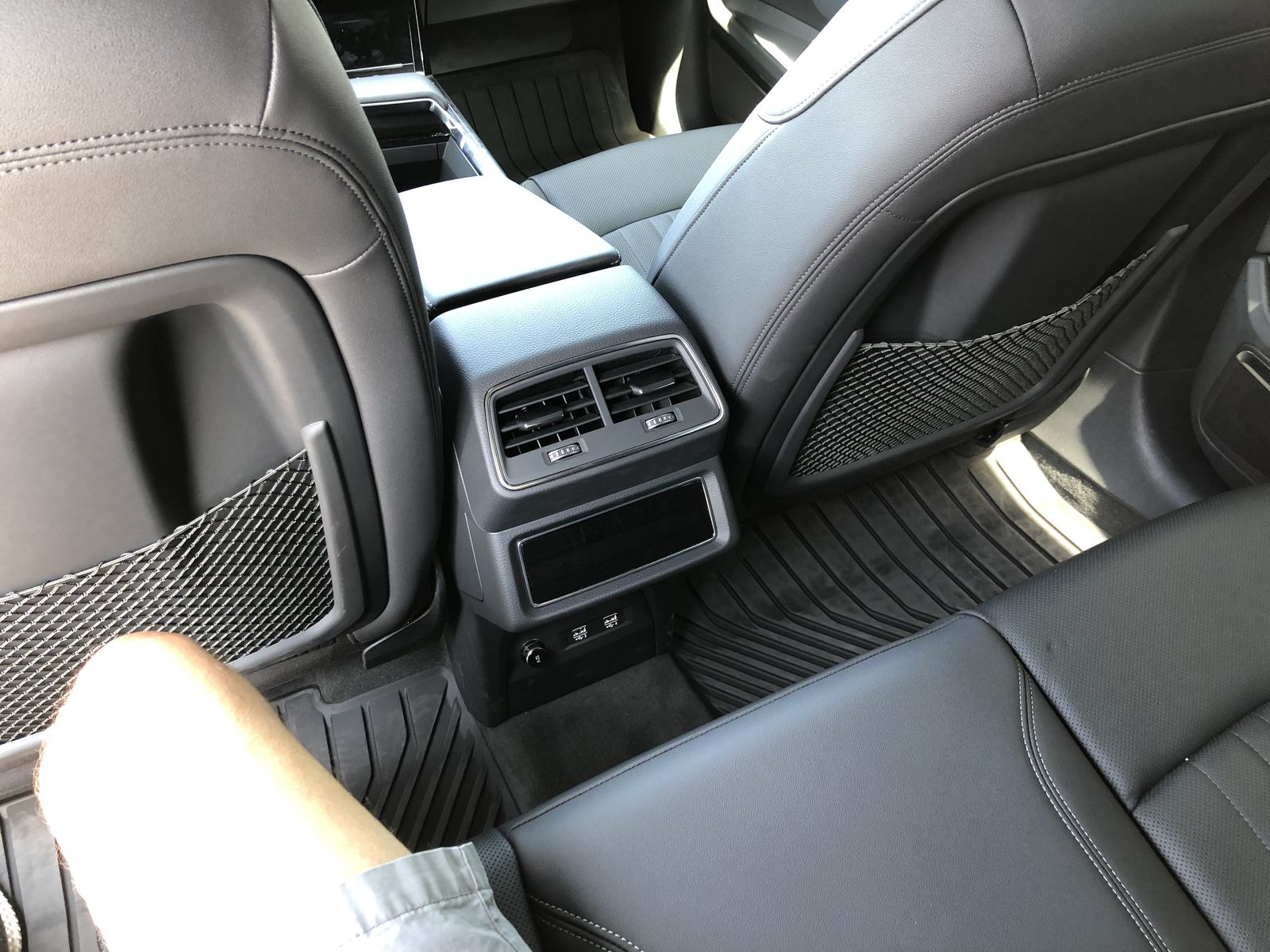
And a wide armrest with storage space for small things and two cup holders:
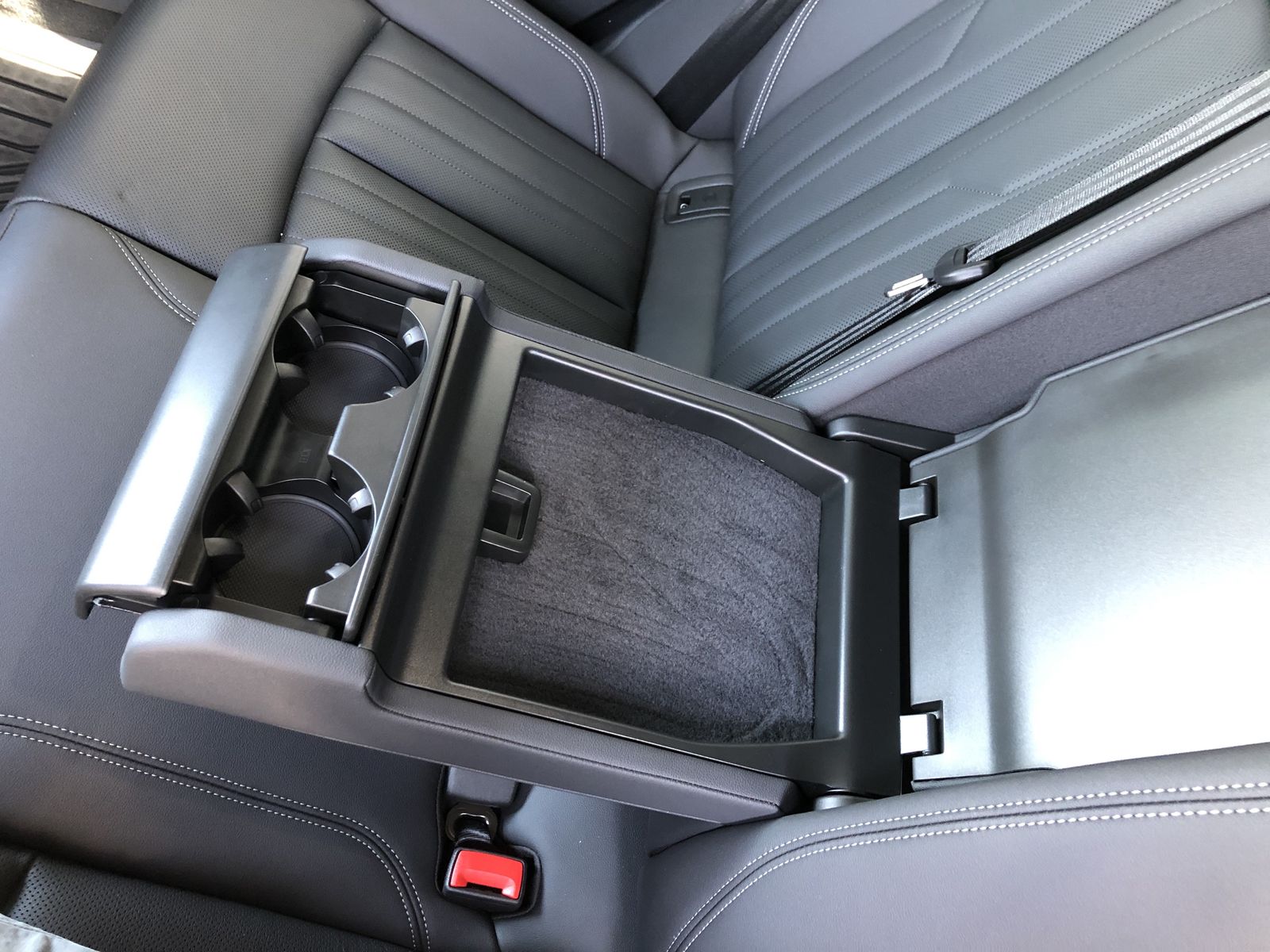
I'm for USB-C, but it's better to just USB for rear passengers than nothing at all (like in my car).
The rear side windows can be closed with additional curtains (no drive). In general, the rear passengers should be comfortable - warm, light and do not bite flies.
The car does not have Self Driving, so we get up from the back sofa and open the driver's door:
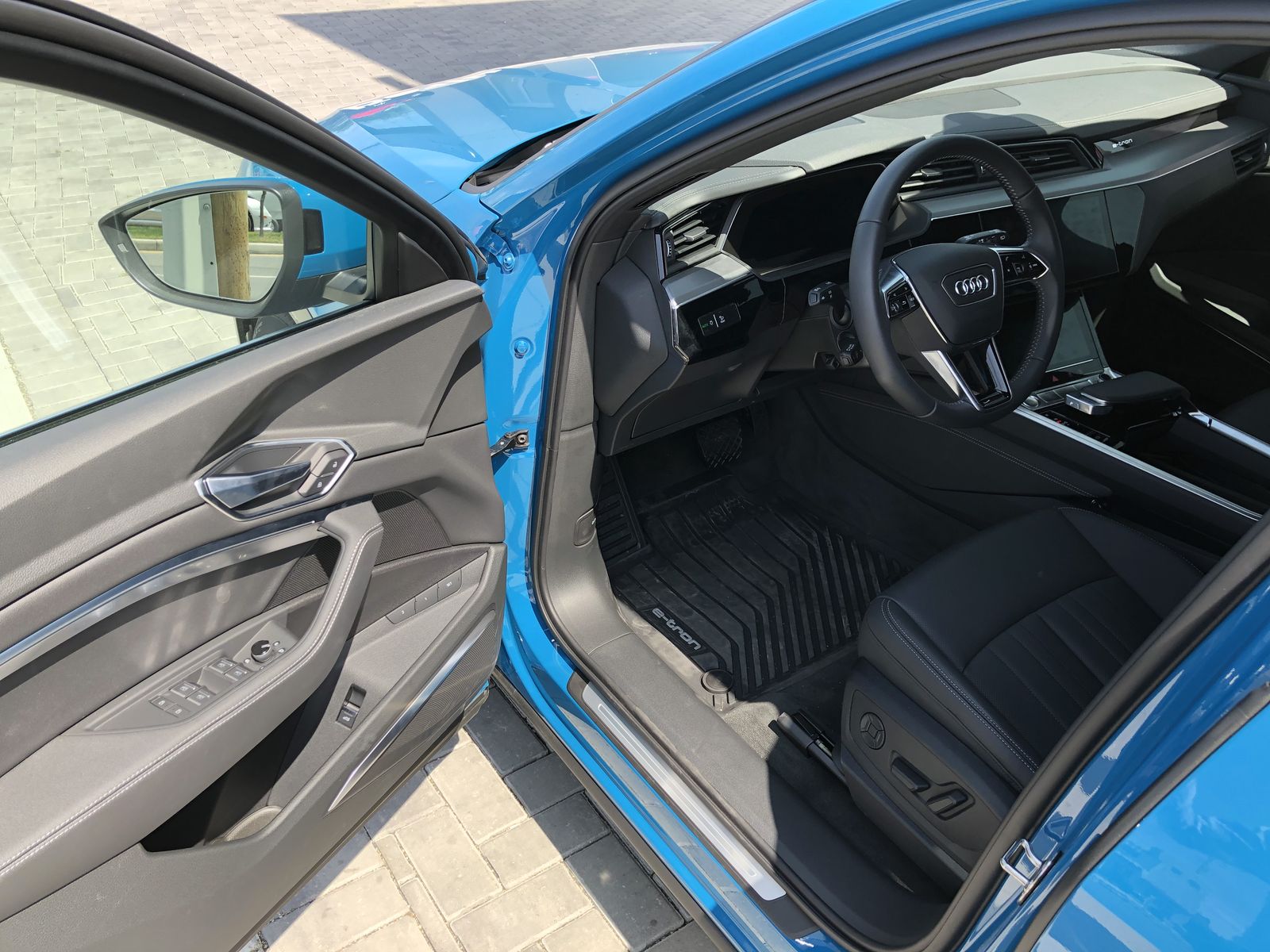
Just like in the rest of the classic Audi. Nothing unusual. You can notice the memory of the seat with 2 settings. In addition, there are driver settings (up to 4 people) in the multimedia system. However, they are in no way associated with the memory of the seat. This is more than strange. The attentive reader most likely already knows what will happen next. Right. Now I will tell you again how it works in Tesla. It is possible to add several profiles in it and in each will be saved all the settings - from the position of the seats and the steering wheel to the preferred multimedia theme. In this case, the profile in Tesla will be automatically selected according to the phone with which the driver approached the car.
The car's interior is the same for the top-end 2019 Audi style.
Audi e-tron:
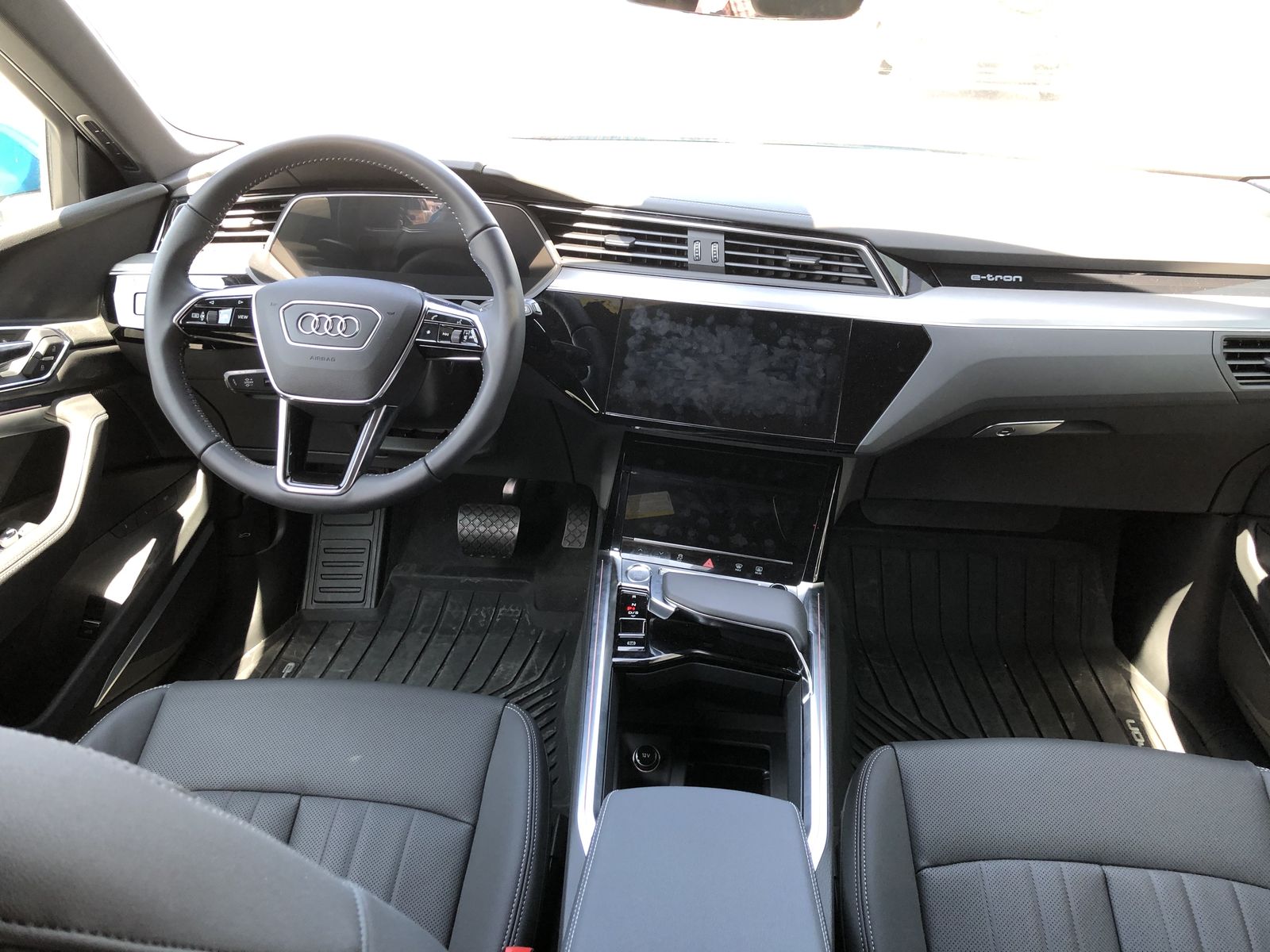
Audi Q8:

Audi A7:
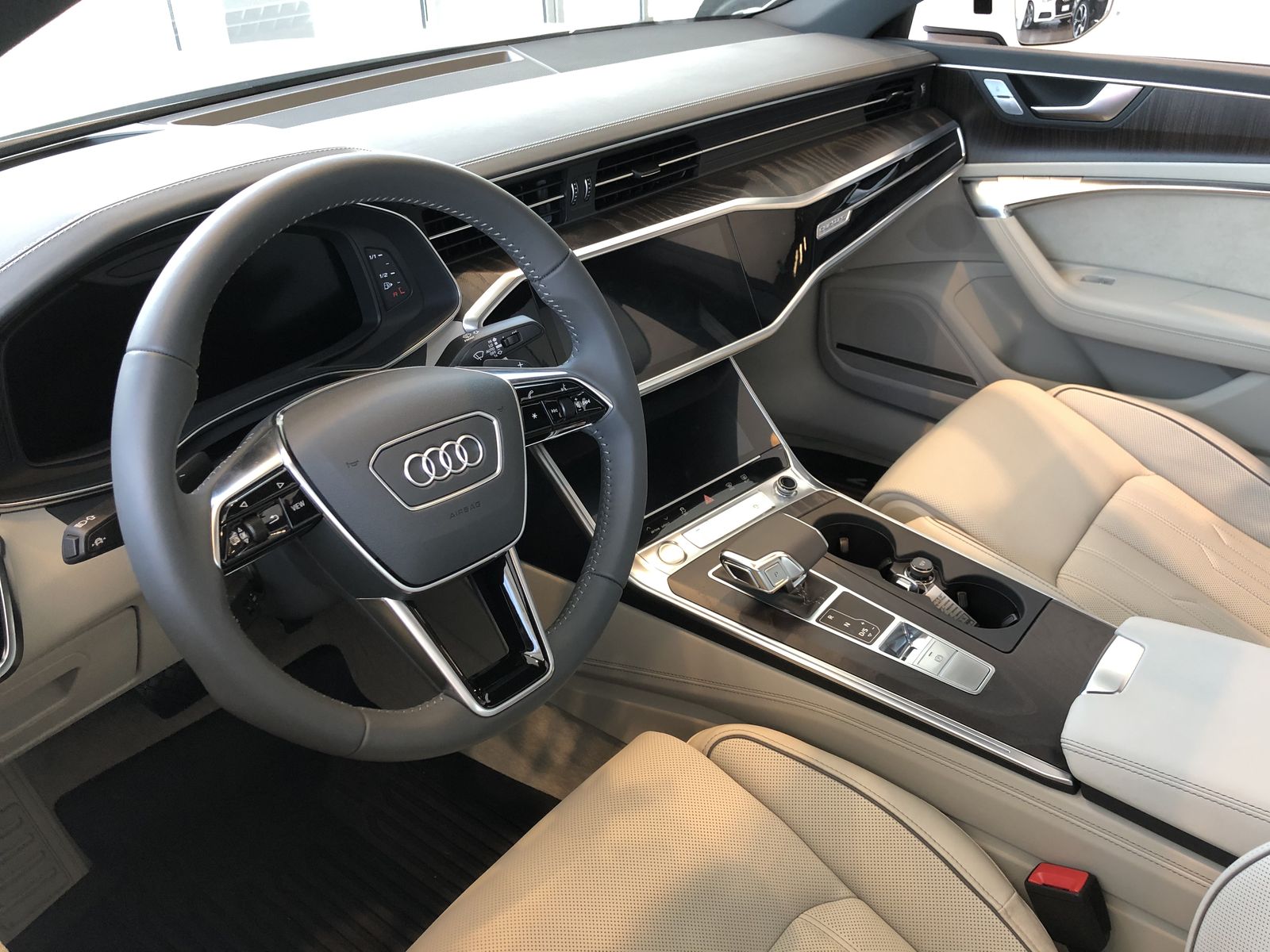
There are differences, but they are very small. The main idea is to catch up with and overtake Tesla and everyone else - put three instead of one screen and give a big rag to wipe all this gloss. Audi on the internal combustion engine - for some reason, “borrowed” the ventilation gap to the entire (or rather almost the entire) width of the cabin as in Model 3, while this was just a decoration - blowing the most common of 4 small zones.
Multimedia is common. Not the slowest, but far from being as fast as Model 3. The abundance of information on the screens is a little annoying. A lot of small text, while the most important is not always easy to find:
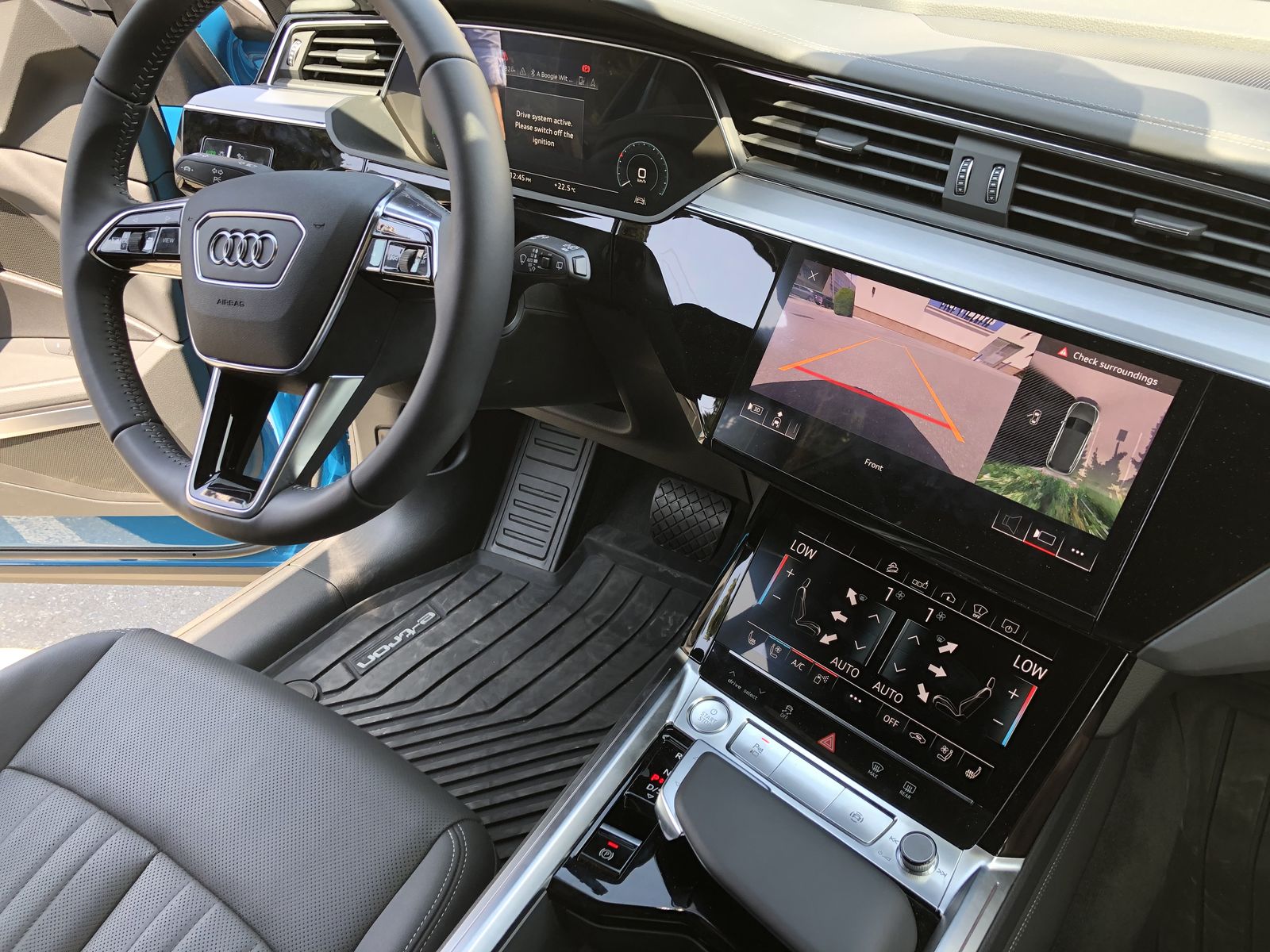
Many features, menus, icons. Confusion. It takes a long time to study what, why and why. Plus, the standard approach for Audi is that if something doesn’t work as we would like, we just add a button so that the user himself chooses what he likes best. For example, on the screen with the climate settings, there is a button that turns off the screen above so that it does not blind the driver at night, while, of course, a screen that does not turn off while driving. Icons can be moved from place to place, thus setting up a quick menu, but all kinds of "improvements" did not help make the UI simple, convenient and intuitive.
In general, take a closer look and answer your question - do you understand what all the icons mean and where to click to get what you need. The situation roughly repeats the situation with the buttons near the interior rear-view mirror in Q7 - there are many buttons that confuse even the driver who drove a car for a year - you need to figure out each time how to turn on the lights or open the curtain, not the sunroof:

Audi left the Start / Stop button. It’s superfluous in an electric car and Tesla has shown it brilliantly - you just sit down and go choosing the direction of travel (D / R / P). In Audi, use the button to turn on the car, and then turn it off.
Screen resolution is not the greatest - pixels are clearly visible. It’s not quite familiar that instead of the usual touch screen, force touch is made. Those. You do not need to touch, namely, press with a little effort on the screen. A rear view camera, which has a variety of modes, including 3d when used, seemed less convenient than just displaying a picture from a wide-angle camera on a full screen. Plus, the color of the car in 3d mode does not match the current one.
The question was constantly in my head - if you still have a scattering of buttons, then why not add a few more for climate control and you can safely throw out one of the screens.
The seats are comfortable. There is no abundance of settings (maybe somewhere in the menu on one of the screens, I did not find it), but there is also heating and ventilation. Although, the manager assured me that the skin is real and of the highest quality, the back sweats in about the same way as in Model 3, until you turn on the ventilation (which Model 3, unfortunately, does not have).
Under the hood:

But it’s not so bad. After all, you can open another lid and find the front trunk there:
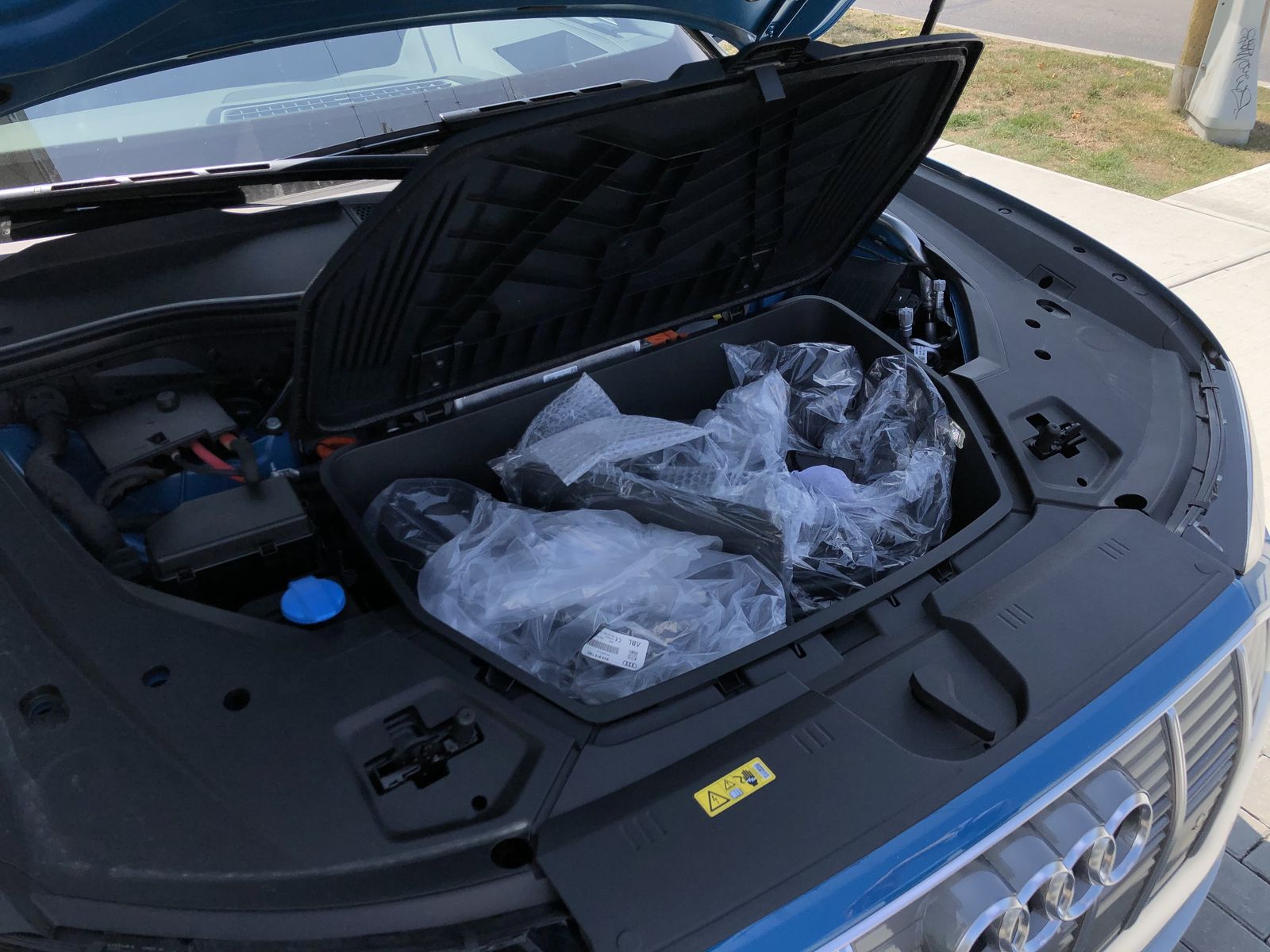
Although. Not. Everything is very bad - this trunk is ridiculously small. Of course, more than in the Jaguar I-Pace, but at times less roomy than in any Tesla.
The charging hatch opens automatically when you press the button and is located near the driver's door, which is more convenient than the back (you can drive to the charging station in front):

As an option, you can install "sockets" on both sides of the car:

At the very bottom of the front bumper there is a radar:

But, time to ride. Someone doesn’t care what the buttons and screens of the e-tron are, and more importantly how it travels - the settings of the adaptive suspension, Audi all-wheel drive and electric motor probably compensate for all the shortcomings that I noticed before starting the trip.
Spoiler
Not. Not compensated.
The mode switch is made in the form of a large palm rest with a swing button on the left - driving towards yourself Drive, away from you Reverse, once again towards yourself Sport Mode, button on the side Parking. Many try to do something unique and Audi does not lag behind.
Turn on Drive mode. We are going. The first thing that catches your eye, or rather in the ears - is a loud enough artificial sound to warn pedestrians that a car is traveling nearby. It sounds like a mixture of bumblebee and a vacuum cleaner. It sounds nicer than the sound produced by the Hyndai Ioniq loudspeaker and even more so than the sound of the Hyndai Kona, but it would be better if it hadn’t been at all (like in Tesla). Unfortunately, it is not disconnected, although it is not necessary according to the laws of Canada and the USA. In my opinion, such a sound is not needed. Why? Because at the moment, many cars with internal combustion engines (especially hybrids) at low speeds also do not produce almost any engine sounds and, as far as I know, there are no studies proving that this "silence" is the cause of some significant number of accidents. And if there is such a study, then why is there no law by which the same loudspeaker is relied on for ICE vehicles?
Choose the fastest available Dynamic plus Sport Mode. Speeding up. Slow down. Speeding up again. Impression of me, as the owner of the EV does not produce any. It is felt that the car is very heavy, so there is no lightness and swiftness from the start, which is available Hyndai Ioniq and Tesla Model 3. This is not to say that it is slow. He is fast. Highly. And decently presses into a chair. But there is no such strong Wow effect as on Tesla with a subjective test (of course, we are talking about those who have traveled to Tesla for some time, and not those who came from the ICE world - for them it will be a huge leap from the past to the future). The usual dynamics of a large and sensations of a very heavy electric car. No more.
The suspension is adaptive and changes the clearance and softness depending on the settings. It rides significantly softer than Model 3 and Ioniq, but the cornering behavior is also much more “cottony” - the center of gravity is higher, the weight is higher, the suspension is softer.
Excellent sound insulation - far ahead of any Tesla - traffic noise is almost inaudible. The only negative is the strong aerodynamic noise near the mirrors at speeds greater than 80 km / h. I hope that the version with cameras instead of mirrors does not have this drawback.
The gas pedal has an acceleration button at the end of the pedal stroke. I would say that this is unnecessary - why break the graph of the acceleration curve with an extra step?
Under the steering wheel there are petals switching recovery modes. There are only 3 modes and the difference between them is not very big. Even at the most powerful, the car slows down completely not actively, which looks strange against the background of even very inexpensive electric vehicles, where the strongest recovery mode allows you to ride in the style of "one pedal".
The most important information is almost hidden on the
There is a head-up display. Speed, strip hold mode and a couple more icons are projected onto the windshield. It looks fine. Do I need it personally? Not.
No autopilot. There is a lane holding mode that works very, very, very poorly (even compared to my Ioniq) starting at only 70 km / h and an adaptive “smart” cruise control with the ability to stop completely and continue driving. E-tron lane retention is essentially a useless function - even on a straight stretch of highway, the car swims very much from side to side and constantly asks to keep your hands on the steering wheel. The cruise control is not located on the steering wheel, but on a separate steering column switch, which is also inconvenient.
Navigation. There is. Check how it works did not work. He pressed the button, said Audi Victoria, he thought about something for a long time and offered to just come to the city of Victoria itself, from which I did not leave during the test. I wrote it off to my pronunciation and asked to say the necessary phrase to the manager accompanying me. He (English native) made 3 attempts, pronouncing the words as clearly and clearly as possible. It did not work out - most likely Audi's speech recognition system could not understand the word Audi. In the end, we agreed to go without a navigator.
As you probably already guessed - the trip did not bring me any pleasure. The manager at some point along the way asked me how the car was. I thought about how to give him a softer and more delicate answer, and without waiting for an answer, he quickly said that he simply works at Audi and I can be absolutely honest with him - this will help more than if I praise the car. After which I admitted that I did not like the car at all - very heavy, not very fast, no autopilot (which I enjoyed using on Model 3), awkward cornering, expensive and incomprehensible. In general, I did not take the time and reduce the already very small mileage before charging the Audi e-tron and relatively quickly returned to the store, parked the car (the rear view camera turned out to be really not comfortable), gave the keys and gladly moved back to your Hyundai Ioniq Electric:
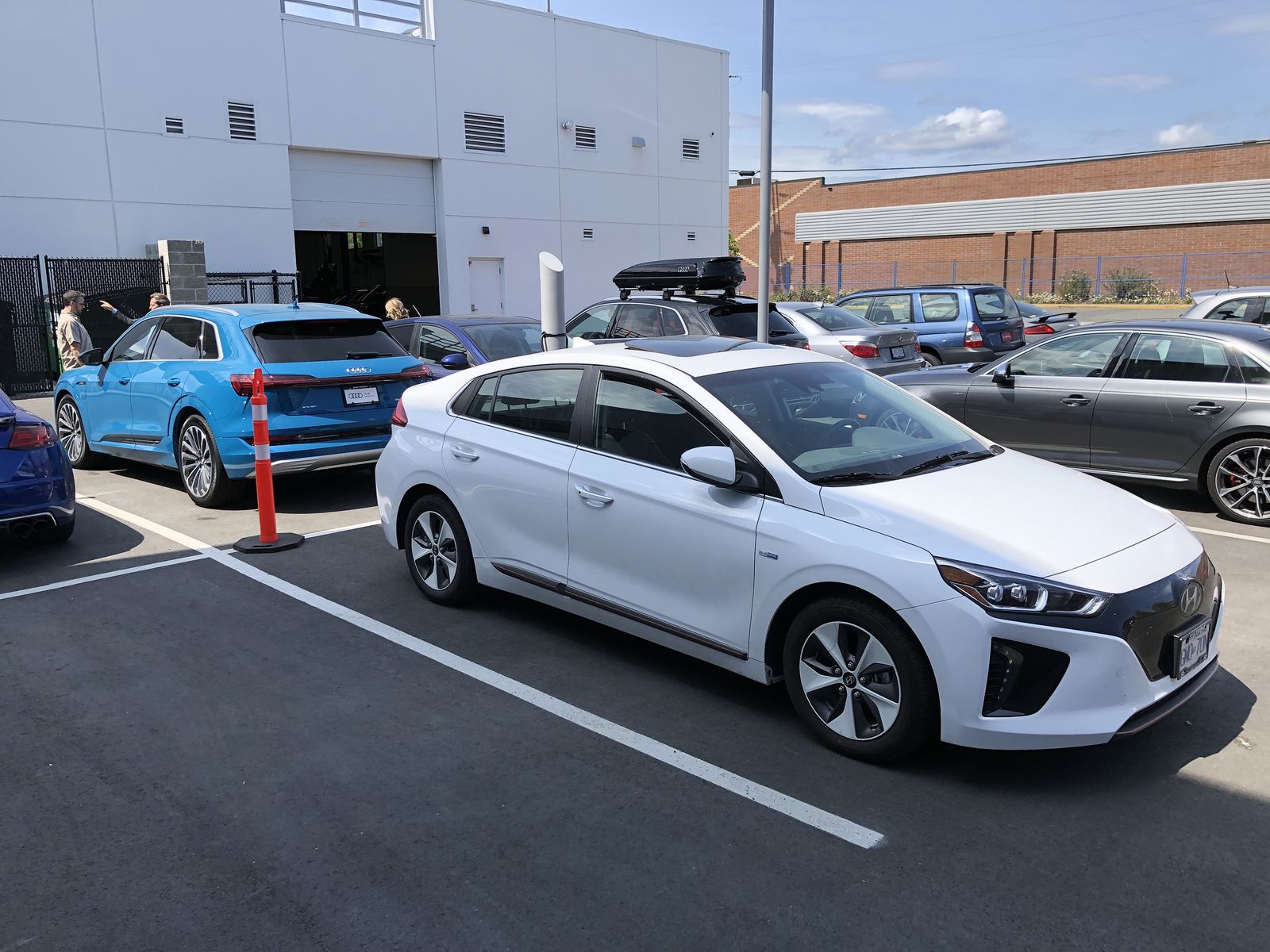
Almost by accident, it turned out that my friend, the owner of Model 3 on the same day also did the Audi Audi e-tron Test Drive, but in Vancouver, BC, CA. He called me immediately after the test, scolded Audi for a long time and, in general, repeated in words my feelings about the trip. He liked the fact that the car rides softer than Model 3, better sound insulation, better seat material, larger, more capacious, but at the same time it’s kind of slow, wadded, no autopilot, uncomfortable UI with a bunch of screens and a high price.
Total
Pros:
- This is an Audi.
- After-sales service Audi.
- Probably a really high build quality and components.
- Spacious.
- Fast and responsive (compared to cars with ICE).
- Good sound insulation.
- Comfortable seats made of good leather.
Minuses:
- This is far from Tesla.
- Outdated ideology and concepts.
- Bad performance in numbers and sensations.
- Unreasonably high price.
- Not the most interesting appearance.
- Outdated for 2019 UI.
According to my personal feelings, Audi tried to make the electric car as similar as possible to a car with ICE and e-tron, with all its appearance and behavior, trying to say - “I am Audi! Same as Q5-Q7! ” The problem is that it is much more expensive than even the Q7 S-Line, while it offers almost nothing to the ordinary motorist, except for environmental friendliness, responsiveness to the gas pedal and other related advantages that are not of interest to everyone.
All Articles